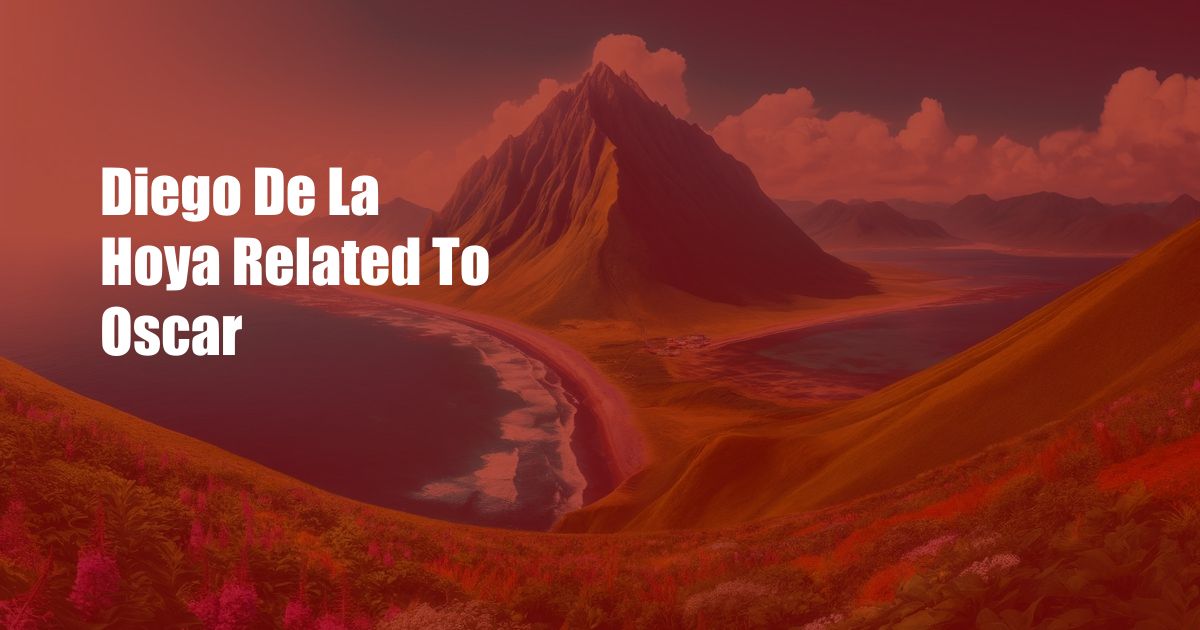
Diego de la Hoya’s Oscar Journey and Impact on the Latinx Community
In the heart of East Los Angeles, a passion for storytelling ignited within a young man named Diego de la Hoya. His dreams took flight when he embarked on a transformative journey to the world of filmmaking. Little did he know that his unwavering determination would propel him to the Oscars, the pinnacle of cinematic achievement, and forever etch his name in history as a beacon of representation for the Latinx community.
His unwavering determination led him to the Academy Awards, where his film “Selma” stood as a testament to the power of storytelling in shaping history. As the lights dimmed and the iconic Oscar statue took center stage, de la Hoya’s heart swelled with pride and a profound sense of accomplishment. That moment marked not only a personal triumph but also a resounding victory for his community. He had broken down barriers and opened doors, inspiring countless young Latinx filmmakers to dare to dream beyond the confines of traditional narratives.
The Evolving Landscape of Latinx Representation in Hollywood
Historically, Latinx representation on screen has been marred by stereotypes and underrepresentation. De la Hoya’s success serves as a catalyst for change, challenging the status quo and demanding a more accurate and nuanced portrayal of Latinx experiences. Through his work, he sheds light on the complexities and diversity within the community, countering harmful stereotypes with authentic and empowering narratives.
His contributions extend beyond the silver screen, as he actively mentors aspiring Latinx filmmakers and advocates for increased representation in all aspects of entertainment. He recognizes the transformative power of seeing oneself reflected on screen, a vital element in shaping positive self-identity and fostering a sense of belonging.
The Significance of “Selma” and its Impact on Civil Rights
“Selma,” a film co-produced by de la Hoya, tells a poignant story of the 1965 Selma to Montgomery marches, a pivotal moment in the fight for civil rights in the United States. Its powerful depiction of the struggle for justice and equality resonated deeply with audiences worldwide, earning it widespread critical acclaim and the Academy Award for Best Picture.
Beyond its cinematic excellence, “Selma” sparked important conversations about race, history, and the ongoing fight for social justice. It became a catalyst for social change, raising awareness about the systemic issues that continue to affect marginalized communities. De la Hoya’s involvement in this monumental project underscores his commitment to using his platform to amplify important voices and create a more just and equitable society.
De la Hoya’s Tips and Expert Advice for Aspiring Filmmakers
Drawing inspiration from his own journey, de la Hoya offers invaluable advice to aspiring filmmakers, particularly those from underrepresented groups:
- Be authentic: Find your unique voice and tell stories that resonate with your experiences. Authenticity will shine through and connect with audiences on a deeper level.
- Seek mentorship: Connect with established filmmakers and industry professionals who can provide guidance, support, and insights.
- Network and collaborate: Build relationships with other creatives, attend industry events, and actively participate in online communities. Collaboration can lead to new opportunities and artistic growth.
Frequently Asked Questions about Diego de la Hoya and Latinx Representation in Hollywood
Q: What is Diego de la Hoya’s most notable achievement?
A: His involvement in the Oscar-winning film “Selma,” a powerful depiction of the 1965 Selma to Montgomery marches.
Q: How has de la Hoya contributed to Latinx representation in Hollywood?
A: Through his films, mentorship, and advocacy work, he challenges stereotypes and promotes more nuanced and authentic storytelling that empowers the Latinx community.
Q: What advice does de la Hoya give to aspiring filmmakers from underrepresented groups?
A: He encourages them to embrace authenticity, seek mentorship, network, and collaborate to break down barriers and amplify their voices.
Conclusion
Diego de la Hoya’s Oscar journey serves as an inspiration for all who dare to dream beyond limitations. His unwavering determination, commitment to diversity, and exceptional storytelling abilities have left an indelible mark on the film industry. As we continue to push for more diverse and inclusive representation on screen, his legacy will guide future generations of filmmakers to create stories that empower, challenge, and provoke thought.
Are you interested in learning more about Diego de la Hoya’s contributions to Latinx representation in Hollywood? Share your thoughts and engage in the discussion below.
 Vikipedi.org Trusted Information and Education News Media
Vikipedi.org Trusted Information and Education News Media



